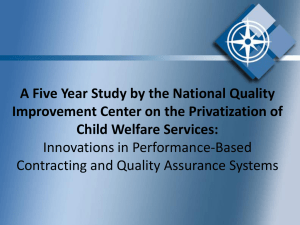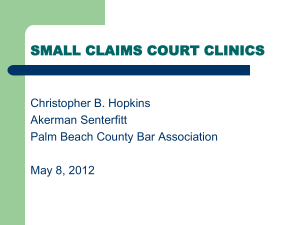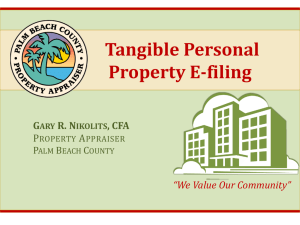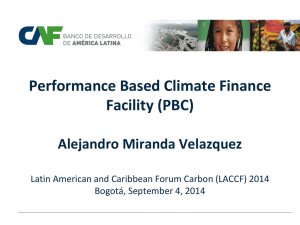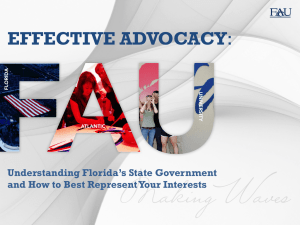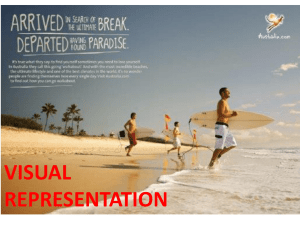State of Education 2013: Palm Beach County
advertisement
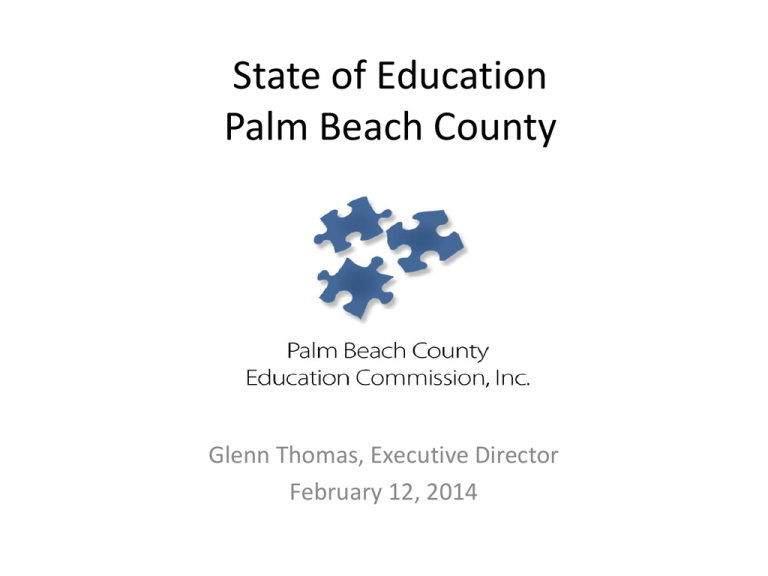
State of Education Palm Beach County Glenn Thomas, Executive Director February 12, 2014 Supports communication and collaboration between all levels of education including training, from early childhood through adult/graduate. This includes public and private entities; local business/industry groups; governmental entities; community based organizations; workforce and business developers; social service providers; and other not-for- profits and foundations to improve student readiness for and access to industry recognized certifications, post secondary certifications, college degrees and in-demand careers. Palm Beach County Six Pillars-2030 Talent Supply and Education Pillar VISION 1. Prosperity and High Paying Jobs 2. Vibrant Communities 3. Global Competitiveness GOAL - Make Palm Beach County a vibrant community, globally competitive providing its residents with prosperity and high paying jobs. • • • Business & Industry Talent Needs (example: Florida-120,000 STEM employees needed by 2020); developing “Human Infrastructure”. Education and Training Focus (67% Industry Certification or Degree) Talent “leakage” (Retention, Graduation, Completion, Placement, Retraining) Today’s Discussion: Why do we care? • Economic Prosperity for All: Education is key. • Safe and Vibrant Communities: Environmental and arts concerns. • Building on our most important resource; children and youth. What are our choices? • Public & Private, PreK-Graduate/Adult. • Pipeline alignments: Education, Business, Industry and Government. How are we doing? • Data Trends: Moving the needle. • Other indicators: Points of Pride. What can we do to move the needle? • Personal and family level. • Business and community relationships. Questions & Responses Palm Beach County as Microcosm of USA 1950 2014 Global: Little global competition Very competitive global marketplace Education: % High School Diploma % High School Diploma, Higher degrees necessary Population: White dominated Diverse Local Industry: Agriculture & Tourism Manufacturing, Service Industry, Medical, Aerospace, Bio Technology, Agriculture & Tourism “Backyard”: Small more isolated Larger, more connected Exchange: Little technology; physical interaction Leveraging many technologies; reduced physical interaction Crime/Violence: Localized, physical Dispersed, technology connected PBC Trends US Census 1980-2030 Projected (graph) 1800000 1600000 1400000 1200000 Hispanics 1000000 800000 PBC Total 600000 400000 200000 0 2000 2010 2020 2012 PBC Students’ Demographics • Early childhood 2012 – 272,686 (children 0-17) – 28% are Hispanic; VPK (4 year olds) students in PBCSD total 1422 – 31% are Hispanic. • Public school district (K-12) 2013-181,126 students – 29% are Hispanic. • PBSC 2013-47,922 students – 25% are Hispanic. • FAU 2013-27,858 students – 9% are Hispanic. PBC Graduation/Completion Rates Palm Beach County School District 2009 2011 2013 School Dist - Hispanic 66.7% 69.8% 75% FL State – Hispanic 63.4% 69.4% 74.9% School Dist – Black 55.4% 61.5% 63.8% FL State – Black 53.7% 58.6% 64.6% School Dist – White 80.3% 85.3% 85.5% FL State – White 71.2% 76.2% 80.5% PBC Has Many Excellent Options • Early Childhood Programs: Children’s Services Council, School District of PBC, Bridges, Quality Rating Systems, training, incentives, networks, etc. – more than 400 licensed centers and 400 family operated facilities. • Palm Beach County School District: VPK Number served by School District = 1422. 185 Traditional schools and special centers, 181,126 students, 20,810 employees. Over 250 Choice programs: Magnets, Career Academies, IB, Advanced Placement, Dual Enrollment, AICE, etc. Virtual options for credit recovery, home schooling, other. 55 Charter schools serving 11,956 students (not including VPK). Pre-apprenticeship, adult education, GED options, etc. Options- continued • Private, independent and religious schools-More than 113 schools, with many grade combinations. • Palm Beach State College with 4 Regional campuses and 100+ programs of study including industry certificates to baccalaureate degrees; community focused, articulated and networked. • Florida Atlantic University with 6 campuses and 170+ programs of study undergraduate and graduate programs, substantial national and international research involvement in Bioscience, Ocean Energy, Medicine and Social issues. Options- continued • 31 Independent postsecondary institutions, colleges and universities with outstanding programs and scholarship in the arts, pharmacy, cultural studies, social sciences, medical, etc. granting certificate, undergraduate, graduate, professional degrees. • Workforce Alliance provides job readiness skills, career training, advising, employment assistance, employer recruitment assistance and on the job supports. • Business Development Board recruits major employers needing highly educated, skilled and trained workforce, as well as assisting expansion of existing business/industry firms. School District of PBC Points of Pride • The ten thousand Palm Beach County School graduates in FY 2012 garnered nearly $80 million dollars in scholarships; 92% say they plan to attend more than 70 colleges and universities worldwide. • Education Week recognized the SDPBC as having the second highest graduation rates in the state, exceeding the state average, and the eight best in the nation. • Newsweek and U.S. News Magazine recognized six high schools in PBC with the distinction of Best High Schools in America 2012. • The PBC School District offers instruction in 6 foreign languages and American Sign Languages; ESOL support for 146 languages. • Florida Ranks 6th Best in the U.S. on National Education Report Card (Education Week) Palm Beach State College Points of Pride • Florida’s first public community college is now the largest institution of higher education in Palm Beach County. • With four locations and 52,000 students annually, Palm Beach State College is the career launch pad for many local professionals ranking 11th in the US in associate degree awards and 13th in associate degrees awarded to minorities. • Many outstanding certificate programs are provided including welding, Biotechnology and Environmental Sciences, Green Construction and Energy. • Nationally recognized degree programs in nursing, with more than 20 health science programs offered. • Palm Beach State College offers four year degree programs to support employer’s growing demand with Bachelor of Applied Science degrees in Supervision and Management, and Information Management. • The Banner Center for Life Sciences includes state-of-the-art, industry driven curriculum products and services deployed statewide. • The Center for Business and Entrepreneurship provides support and start up services including the Small Business Development Center. FAU Points of Pride • FAU students hail from all 50 states and more than 180 countries, engaged with the activities of 250 clubs and campus organizations. • The Princeton Review has included FAU’s College of Business on its 2011 list of Best Business Schools. • The School of Accounting consistently ranks in the top 10 nationally for its graduates’ high passing rate on the National CPA Exam. • The field of Ocean Engineering was pioneered at FAU, in 1965 with the first Department of Ocean Engineering in the country remaining a leader engineering education and research through the only NSF funded “Energy from the Sea” lab on the east coast. • Students in FAU’s Christine E. Lynn College of Nursing achieved a passing rate of 95.77 percent on the national licensing exam. • With more than half of its student body classified as minority or international students, FAU ranks as the most racially, ethnically and culturally diverse institution in Florida’s State University System. • Harbor Branch Oceanographic Institute is an internationally recognized research center for underwater exploration, medicines from the sea, and sea/estuarine life studies. • Medical College, Scripps, Bio Science opportunities. Future Economic Trends • Globalization PBC diversity is a cultural and employer benefit. Latin America as trading partner with emerging economies (Port for Agriculture/NJ and Ohio). Global understanding including student language fluency and cultural understanding (student exchange on all levels grow adult networks). Distributed research/development, manufacturing distribution, marketing/sales and reclamation. Talent Supply and Education Six Pillars 2030: Increase PBC median wage • Support STEaM, skills, concerns of employers • How: Move percentage of working age citizens holding an industry certification or degree to 67% by 2030 (currently at 47% US Census) (2011 20% working age adults in PBC started, did not complete certification or degree) • Paired with recruitment of high skill/wage firms • Challenge: Raise all PBC demographic segments System Strengthening • Higher standards; broad and meaningful involvement at all levels; system feedback data and improvement. • Better articulation/conversations/connections-for transitions. • More connections outside Education or Training • More meaningful involvement in Education or Training by and through all community segments. • Stronger family understanding and involvement at each level using all outreach agencies and mechanisms (common message for common ends) . The effort put forth by parents has a bigger impact on their children’s education achievement than the effort expended by either teachers or the students themselves. Must Try Harder: Evaluation the Role of Effort in Educational Attainment. Review of Economics and Statistics, August 2010 Make a Difference: Take aways for Chamber Members Early Childhood • • • Talking with child (higher order versus “business” like “come here” or “stop that”) : 0 to 4 years old, 30 million words. Family reading aloud or picture books (set examples, find regular time 1530 minutes) . Everyday learning (grocery stores, car, household objects-what, why, how, math, etc.). Elementary School Level • • • • Child or joint reading aloud (“summer slide”, 30 minutes, leveled books/ebooks, magazines, example CSC-Literacy Coalition with School District and Bridges centers). Reducing school absences (absenteeism breeds lack of success, > 10 indicates potential risk factors) Family, Community expectations including mentoring, role models, visitations, etc.). “Why” of science and math – taking things apart, math as a key tool of STEaM. Make a Difference: Take aways for Chamber Members Middle School Level • • • • One friend in all settings reduces bullying. Reducing school absences; by looking at barriers and successes. Connections and involvement in activities both in school and outside of school. Use all resources to learn including peers, technology, mentors & role models. High School Level • • • • • Career academies, applications of learning, and industry certifications. Reducing school absences by looking at caregiver, part-time job, other barriers. Involvement in activities both in school and outside of school. Planning and expectations to garner opportunities through service and internship learning, mentor relationships, information, family expectations and reality. Get a head start into Post Secondary and career through advance academics/dual enrollment/internship opportunities. Make a Difference: Take aways for Chamber Members Post Secondary • Transition to new culture, speed, (and time management), priorities, finances, etc. • Parental expectations and support (focus long term). • Networking to leverage community resources and contacts to potential employers. • Connection to others (study groups “learning communities”), learning resources and supports (social, legal, behavioral, financial, research/scholarship. Some Potential Chamber Actions • Florida Students left $100 million- Pell Grants on table in 2013 – FASA (grants versus loans). • Mentoring, role modeling, career days, connection to service opportunities, support expectations, etc. • Paid or unpaid internships (students), externships (teachers). • Outreach to organizations, media, families and students to support local education initiatives like “Parent Academy”. • Training, information and support to families and other organizations—connections at all levels for a variety of services, resources and opportunities.
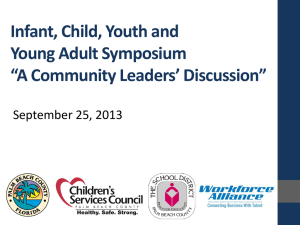
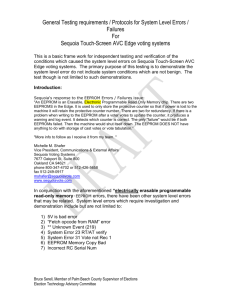

![PERSONAL COMPUTERS CMPE 3 [Class # 20524]](http://s2.studylib.net/store/data/005319327_1-bc28b45eaf5c481cf19c91f412881c12-300x300.png)

